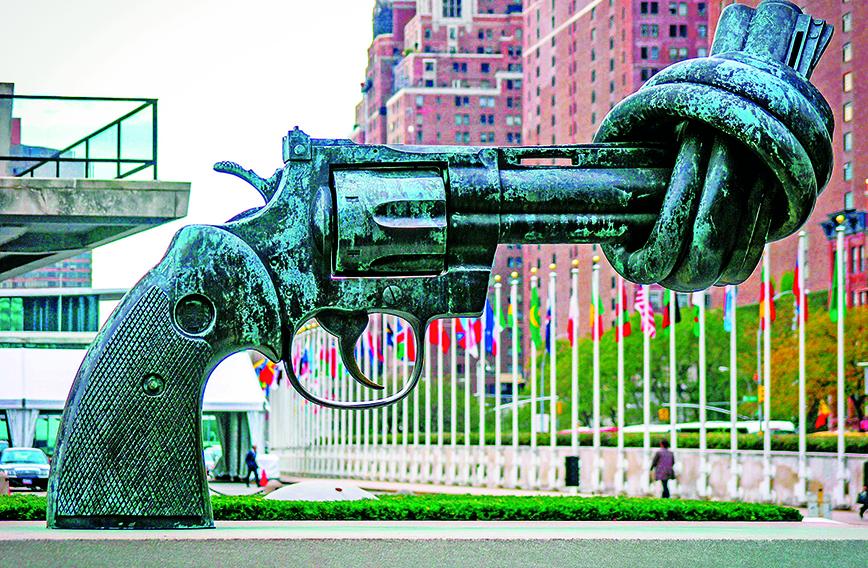

RAJNI BAKSHI
WE live in an age of many firsts. We are the first humans to have a ‘Doomsday Clock’ as well as an International Day of Nonviolence. What do we make of this contrast? Does the Doomsday Clock seem more real than The Knotted Gun outside the United Nations?
The Doomsday Clock is a symbolic way of keeping track of how close we are to a human-made global catastrophe. The clock came into being in 1947 as scientists were grappling with the implications of having invented nuclear weapons. Maintained since then by the Bulletin of Atomic Scientists, the clock is a way of estimating threats posed by unchecked scientific and technological advances.
To start with, the clock only took into account the degree of risk of nuclear weapons being deployed. Now the clock also accounts for the dangers posed by climate change as well as developments in life sciences that could cause irreversible harm to humankind.
By contrast the United Nations’ International Day of Nonviolence is premised on the hope that our species’ finer traits can eventually lead us to forms of organization where both individuals and groups feel strong enough to be nonviolent. A UN General Assembly resolution passed in June 2007 chose Mahatma Gandhi’s birthday as the International Day of Nonviolence.
In doing this all nations of the world, at least formally, accepted the universal relevance of the principle of nonviolence. It remains to be seen how many social and political leaders across the world actually accept Mahatma Gandhi’s confident claim that nonviolence is “mightier than the mightiest weapon of destruction devised by the ingenuity of man”.
The absurdity of violence had already been artistically expressed at the United Nations two decades earlier — in the form of a bronze sculpture called Nonviolence but better known as The Knotted Gun. This is a large sculpture of a Colt Python 357 Magnum revolver with its barrel tied in a knot. It was made by Carl Fredrik Reutersward in response to the murder of his friend, John Lennon. This was his way of honouring Lennon’s advocacy of peace and nonviolence — most famously through the song “Imagine”, which Lennon co-wrote with Yoko Ono and released in 1971.
The Knotted Gun, which is the centrepiece of the UN plaza, was also the artist’s way of poking fun at violence. Reutersward knew that humour is a fine way to bring people together. So he deliberately set out “…to make my ‘weapon’ symbolically ridiculous and completely out of order”.
However, for most people it is the Doomsday Clock which is a far more compelling symbol. The most obvious reason for this is that an imminent danger tends to be rivetting. By contrast, advances in nonviolence appear amorphous and cannot be ‘clocked’ in the way that impending doom can be.
For instance, when the Doomsday Clock was first conceptualized scientists evaluated the risks of nuclear weapons and came to the conclusion that humanity was just seven minutes away from midnight, the symbolic marker for a global catastrophe that would destroy life as we know it.
Since then, there were only two instances when the Doomsday Clock was more than 10 minutes from midnight. It stood at 12 minutes in 1963 when the United States and the Soviet Union signed the Partial Test Ban Treaty, limiting atmospheric nuclear testing. It stood at 14 minutes in 1995 following the dissolution of the Soviet Union and the ending of the Cold War. 1972 — 12 mins — SALT and ABM Treaty. 1991 — 17 mins — START I and fall of Soviet Union. 1995 — moved to 14 mins — NATO expanded east, fears of Russian reaction.
In the past three decades the situation has rapidly deteriorated as more countries have acquired nuclear weapons and efforts to address climate change have been too little too late. Given the tensions between the US and Russia, as well as the US and Iran, in 2020 the Doomsday Clock moved to less than two minutes from midnight. Currently, largely due to the threat of the conflict in Ukraine triggering a nuclear war, the clock stands at one and a half minutes to midnight.
While these geopolitical events are well known, few people are aware that in the same seven decades that the Doomsday Clock has been ticking away scores of nonviolent struggles have succeeded across the world.
A study titled “Why Civil Resistance Works: The Strategic Logic of Nonviolent Conflict” by Erica Chenoweth and Maria Stephan has shown that for over a century campaigns of nonviolent resistance have been twice as successful as those that relied on violence. One major reason for this is that the nonviolent campaigns are able to involve a much larger and wider range of people.
The problem is that these nonviolent forms of civic mobilization seem to exist in some different time and space realm — one that does not impinge on the realities that have brought the Doomsday Clock so close to the catastrophe marker.
Thus, many people tend to look wistfully upon The Knotted Gun outside the UN and see it only as symbolic of one dimension of human aspirations but not a real possibility. There is a not so obvious and insidious reason for this. We are conditioned to believe that violence is ‘natural’ whereas nonviolence is a learnt behaviour, a moral and ethical aspiration.
The good news is that this conditioning too has been amply challenged. More on that next time.
Rajni Bakshi is the founder of YouTube channel Ahimsa Conversations
Comments
Currently there are no Comments. Be first to write a comment!



